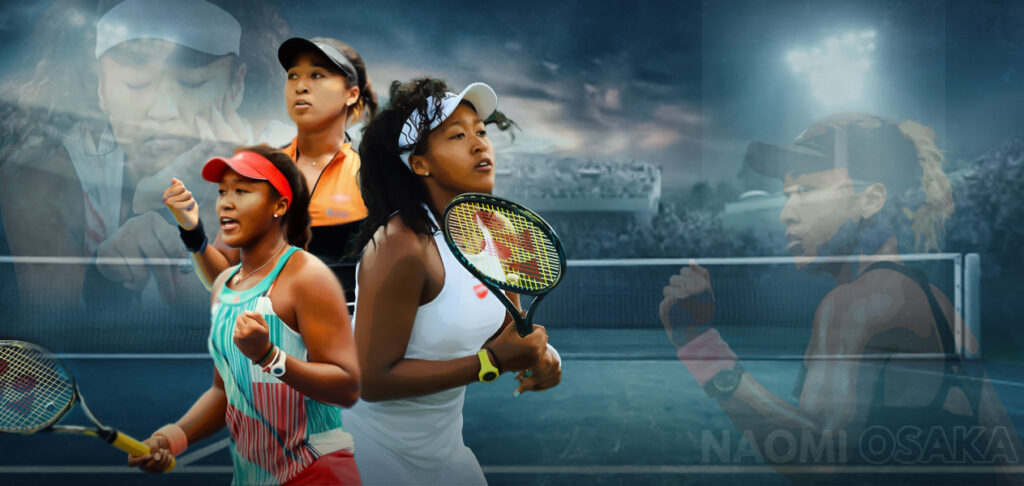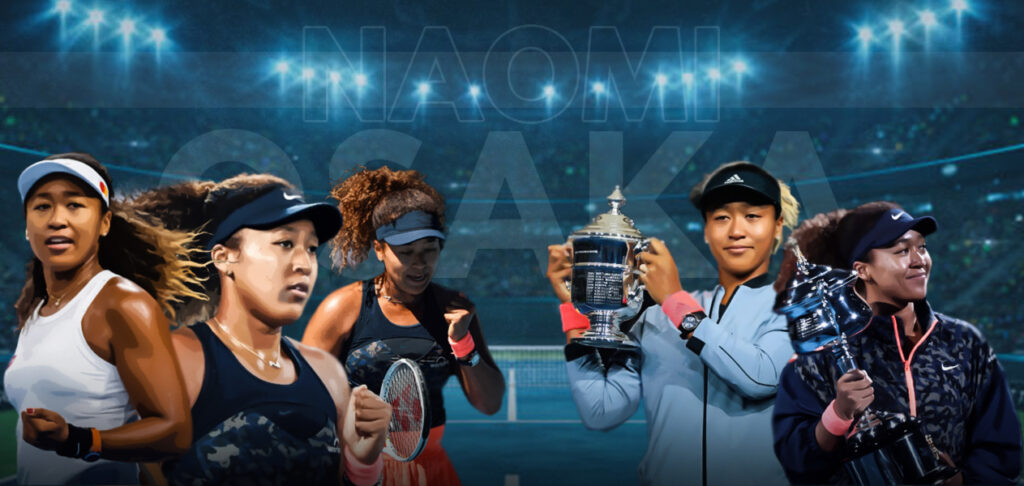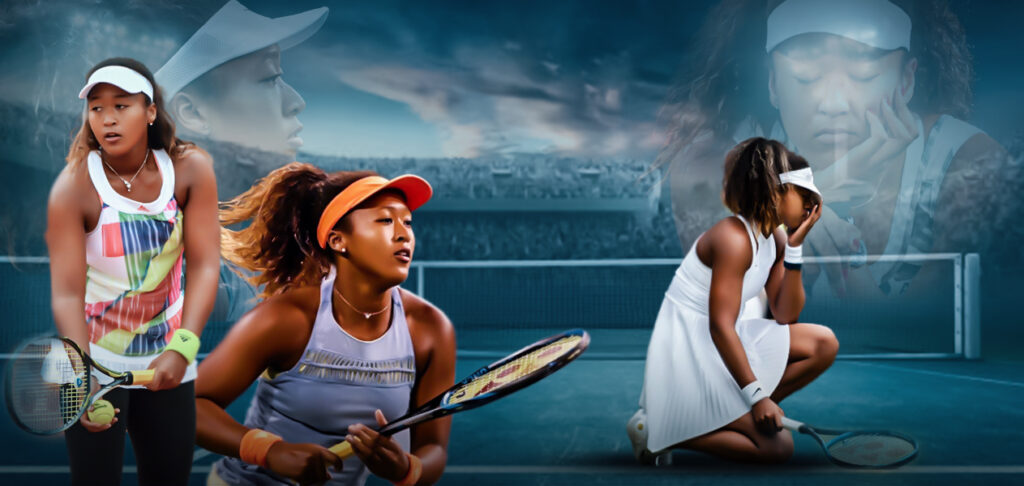Naomi Osaka: From a shy youngster to a global voice.
From Billie Jean King to Martina Navratilova, these greats of the game have tirelessly courted the media as they promoted women’s tennis. With the rise of social media, prominent athletes now recognise the power they hold, the direct access they have with their fans, and that they no longer need the media – as Naomi Osaka stunned the tennis world by pulling out of her tour-mandated press conferences during the Roland Garros.
Humble Beginnings
 Born on 16 October 1997, in the city of the same name in Japan, the beautiful Osaka, from a family with a Haitian father and a Japanese mother, a hafu – the sons and daughters born to a Japanese parent and a different nationality are called in Japan – the girls had to take up their mother’s name as a result.
Born on 16 October 1997, in the city of the same name in Japan, the beautiful Osaka, from a family with a Haitian father and a Japanese mother, a hafu – the sons and daughters born to a Japanese parent and a different nationality are called in Japan – the girls had to take up their mother’s name as a result.
At the age of three, the family moved to Long Island, New York and her father, inspired by the Williams sisters playing in the 1999 Roland Garros, decided to teach his daughters the same. Naomi’s father took her and sister Mari Osaka to public tennis courts and trained his daughters with the help of instructional books and DVDs from Richard Williams.
Apparently, the family moved to Florida in 2006 to further their careers and provide a solid foundation for the girls to climb up the tennis ladder. After her elementary studies, Naomi fully devoted herself to tennis at the Florida Tennis SBT Academy and the ProWorld Tennis Academy. Although Osaka was raised on the U.S. shores, her parents decided as early as when she was ten, that their daughter would be representing Japan.
In 2013, Naomi turned professional just before turning 16-years-old. She qualified for her first WTA Tours finals draw in the 2014 Stanford Classic, where she upset the then World No. 19 and former US Open champion Samantha Stosur, saving a match point in the second set tie-break and coming back from 5-3 down in the third set. She was just 16-years old and her exploits garnered praise from all around the world.
Also Read – Rafael Nadal: Wobble, or a great concern?
Cream of the Crop
 The 23-year-old’s rise to the top started very early. In 2018, she imposed herself in front of a packed crowd by winning the Indian Wells Open. But that was just the appetizer. Six months later, on the hard-courts of Flushing Meadows, she won her first Grand Slam, the US Open, beating her childhood idol Serena Williams that descended into boos from the crowd and tears from the newly minted champion.
The 23-year-old’s rise to the top started very early. In 2018, she imposed herself in front of a packed crowd by winning the Indian Wells Open. But that was just the appetizer. Six months later, on the hard-courts of Flushing Meadows, she won her first Grand Slam, the US Open, beating her childhood idol Serena Williams that descended into boos from the crowd and tears from the newly minted champion.
Osaka made it back-to-back Grand Slam titles four months later, winning the 2019 Australian Open after an enthralling battle with Czech Petra Kvitova. Osaka’s win down under saw her become the first Asian player (man or woman) to be crowned the World No. 1, and also the youngest since Caroline Wozniacki, in 2010.
Sascha Bajin, a hitting partner of Serena Williams and later Naomi’s coach from the start of 2018, saw the meteoric rise of this potential superstar. Osaka was the 72nd ranked player when Bajin joined her and added new elements to her game. Like her idol, Naomi now had a dangerous serve with rifling groundstrokes, while raising her mental game to play clutch tennis under pressure.
After her second Grand Slam title, the two parted ways after a conflict of interest though the two have not detailed their separation to date. Jermaine Jenkins, who had previously worked with Venus Williams as a hitting partner, was hired as her new coach. But the newly crowned World No. 1 struggled after her exploits in Melbourne and bowed out of most tournaments in the early stages, which resulted in Ashley Barty dethroning her from the World No. 1 spot.
Naomi finally hired Wim Fisette as her new coach at the start of the 2020 season but a shock defeat at the hands of teenage sensation Coco Gauff in the third round of the Australian Open, and the subsequent death of her mentor, Kobe Bryant, completely rocked Naomi to the core. With the coronavirus pandemic suspending the tennis tour for more than five months, Naomi had the perfect opportunity to rise from her setbacks and raise her game both on and off the court.
Osaka only played four tournaments in 2020, but she reached the Cincinnati final in her first tournament back, but had to pull out with injury ahead of her final against Victoria Azarenka. It wasn’t long before the two faced off against each other again, this time though, on the Arthur Ashe Stadium as both players progressed to the US Open Final. In the final, Osaka needed all her growing maturity to recover from a set down to rally back and win the next 10 out of the possible 12 games to thwart Azarenka’s dominance and win her second US Open title.
That victory was her last match of the season, as a week later she pulled out of the rearranged French Open with a hamstring injury. Earlier this year, Osaka breezed past opponents in the first week of the Australian Open to set up yet another hard-court Grand Slam final, beating the likes of Hsieh Su-Wei and Serena Williams, to set up a final against big-hitter Jennifer Brady. Brady provided a stern test before Naomi’s defence and persistence eventually forced some glaring errors from her opponent. With this victory, Naomi Osaka became the first women’s player to win her first four Grand Slam finals since Monica Seles in 1991.
A personality deeper than an Ocean
 Once painfully shy and uncomfortable in front of the spotlight, things changed during the covid pandemic when Naomi raised her voice against the racial injustice in the United States. Sweet, calm and quirky in her press conferences, but tremendously powerful when needed. Naomi is a different person on the surface level, but if one descends deeper under the surface, lies a personality that is sweet and strong at the same time, determined, humble, reserved and composed. Very deep, despite her age.
Once painfully shy and uncomfortable in front of the spotlight, things changed during the covid pandemic when Naomi raised her voice against the racial injustice in the United States. Sweet, calm and quirky in her press conferences, but tremendously powerful when needed. Naomi is a different person on the surface level, but if one descends deeper under the surface, lies a personality that is sweet and strong at the same time, determined, humble, reserved and composed. Very deep, despite her age.
Naomi Osaka, 23, is a champion who is gaining fame at the rate of knots, not only thanks to her remarkable performances on-court, where she won four Grand Slam titles but also off-court, thanks to her fearless political choices, social commitments and some out of context controversies (but hey, aren’t we all subject to some). Even those in her birthplace scorned her for speaking out about racial injustice and encouraging people to join a Black Lives Matter march.
Amidst numerous murders linked to black people getting killed by the police in the United States in 2020. In the ensuing US Open, Naomi took the court seven times with seven different masks, all with different names of victims, in the final against Victoria Azarenka, she chose to pay homage to Tamir Rice, a 12-year-old boy who died from a bullet fired by the Cleveland police in 2014. Her involvement was widely praised all around the world, with many prominent figures backing the 23-year-old for her drive and belief in social justice.
Also Read – SERENA WILLIAMS – THE JOURNEY SO FAR
Media snub – A smart choice and an overdue conversation
 For decades now, a professional athlete is expected to be available for the media, in fact, it’s not just expected, it’s required – with the threat of financial punishment or suspension for those who don’t comply. So, if you are a 10-year-old dreaming to be a sports superstar, you better be prepared to answer questions, whether you like it or not, no matter how you’re feeling. That is why I thought Naomi Osaka’s recent statement – in which she highlighted how the toll of interacting with the media has negatively affected her mental health – is a quite powerful one.
For decades now, a professional athlete is expected to be available for the media, in fact, it’s not just expected, it’s required – with the threat of financial punishment or suspension for those who don’t comply. So, if you are a 10-year-old dreaming to be a sports superstar, you better be prepared to answer questions, whether you like it or not, no matter how you’re feeling. That is why I thought Naomi Osaka’s recent statement – in which she highlighted how the toll of interacting with the media has negatively affected her mental health – is a quite powerful one.
The greatest source of friction to her story is undoubtedly her 2018 US Open triumph over Serena Williams. Osaka clearly had no idea of Williams’ game penalty during the match, but it was all anyone could ask her for weeks after her first Grand Slam title. Similarly, four months later, when she won her first Australian Open title, she was understandably upset by the first question of her winning press conference, where a male journalist quipped in, “Apparently you’re unable to win a slam without some drama.” Years on, and there is still a tendency to pit Williams and Osaka against each other.
But the issue is, when Osaka speaks, people listen. Without her quirky and funny commentary, the world of tennis will lose out on one of its most influential voices. So when on Sunday, after her first-round win against Romania’s Patricia Maria Tig she missed her media obligations following the match, she was imposed a fine of $15,000 by the organisers.
“We have advised Naomi Osaka that should she continue to ignore her media obligations, she would be exposing herself to possible further code of conduct infringement consequences. As might be expected, repeated violations attract tougher sanctions, including default from the tournament and the trigger of a major offence investigation that could lead to more substantial fines and future Grand Slam suspensions,” said the organisers in a statement.
Following the same, Naomi agreed to the on-court interview. On Sunday, she sent out a tweet, stating, “Anger is a lack of understanding. Change makes people uncomfortable.” Meanwhile, the French Open twitter handle was quick to jump on it, as it had posted a tweet at the same time, which involved the picture of Rafael Nadal, Kei Nishikori, Aryna Sabalenka and Coco Gauff speaking to the media. The caption read, “They understood the assignment.” But, following widespread backlash from fans, the tweet was later deleted.
French Tennis Federation (FFT) president Gilles Moretton took a seat in the press conference room in Paris on Monday. Dressed neatly in a white shirt and a black blazer, he read out a statement in French, then English and made way for the exit door. A total of 85 words in English and 94 in French, which was less than five minutes. Interestingly, he took no questions from the media joining in virtually – even those inside the room. The irony wasn’t lost on anyone.
That same afternoon, in a social media post, Osaka stated she was pulling out from the tournament. “I think now the best thing for the tournament, the other players and my well-being is that I withdraw so that everyone can get back to focussing on the tennis going on in Paris. I never wanted to be a distraction and I accept that my timing was not ideal and my message could have been clearer,” Osaka wrote. “More importantly, I would never trivialize mental health or use the term lightly. The truth is that I have suffered long bouts of depression since the US Open in 2018 and I have had a really hard time coping with that.”
To aggravate Osaka’s desire to skip press conferences over her mental health and well-being with Novak Djokovic, after being defaulted, is a gross misreading of the situation by the FFT. When something as complex as mental health needed to be treated with tenderness and empathy, the organisers’ heavy-handed approach made things extremely resentful.
Moretton’s statement on Monday highlighted how far the tournaments and the tour have to go in dealing with mental health. “First and foremost, we are sorry and sad for Naomi Osaka. The outcome of Naomi withdrawing from Roland-Garros is unfortunate. We wish her the best and the quickest possible recovery, and we look forward to having Naomi at our Tournament next year,” he said. “Recovery” as if she was dealing with a hamstring injury or a twisted knee.
Press conferences are often not enjoyable for athletes and speaking to a player after a major loss or a devastating moment requires both sensitivity and tact that is sometimes missing. Naomi has laid out, clearly and concisely, the issues affecting her and that she’d be willing to take the fines not to have to deal with the stress anymore. Meanwhile, with tension and expectations soaring high as the Tokyo Olympics approaches, by not speaking with the media, it rather seems like the 23-year-old is protecting herself from the pressure to come.
The intervention from the governing body is a debatable one, since letting her off the hook would allow other top players to boycott their media obligations as well. But on an issue that needed to be dealt with smartly and cautiously, the organisers dropped the ball in cold blood and no one came out looking pretty.
Written By
Rahul Saha

